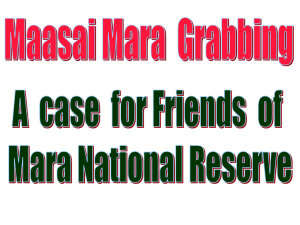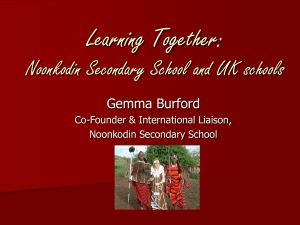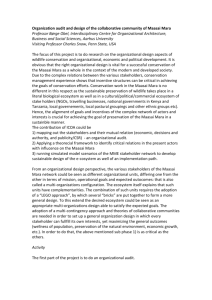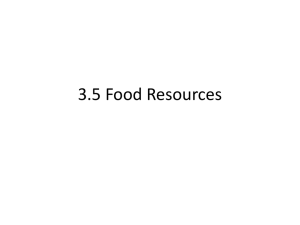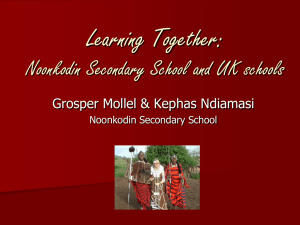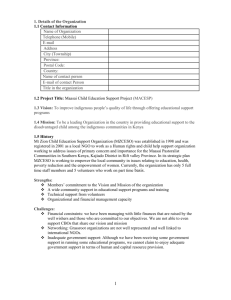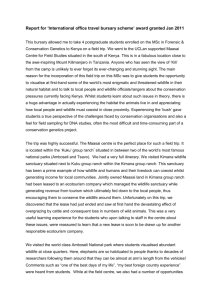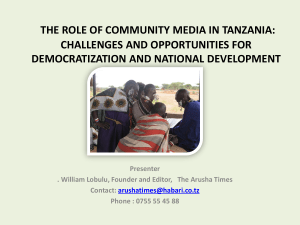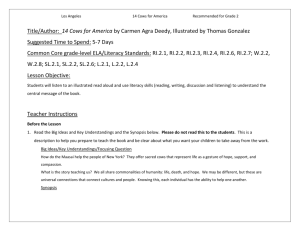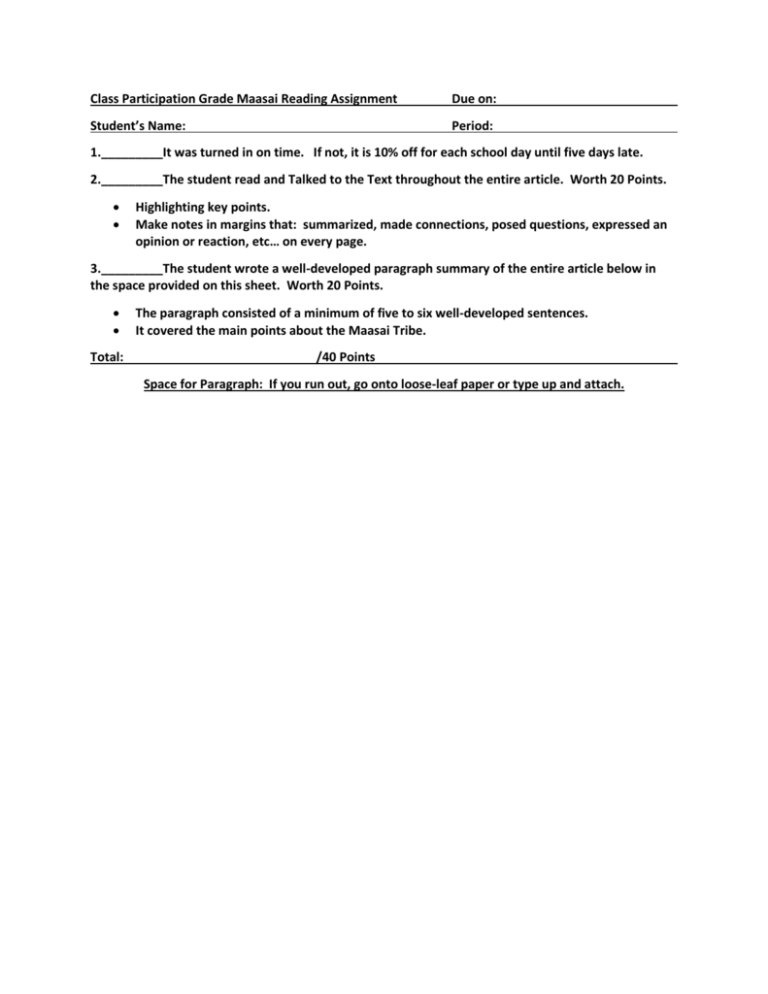
Class Participation Grade Maasai Reading Assignment
Due on:
Student’s Name:
Period:
1._________It was turned in on time. If not, it is 10% off for each school day until five days late.
2._________The student read and Talked to the Text throughout the entire article. Worth 20 Points.
Highlighting key points.
Make notes in margins that: summarized, made connections, posed questions, expressed an
opinion or reaction, etc… on every page.
3._________The student wrote a well-developed paragraph summary of the entire article below in
the space provided on this sheet. Worth 20 Points.
Total:
The paragraph consisted of a minimum of five to six well-developed sentences.
It covered the main points about the Maasai Tribe.
/40 Points
Space for Paragraph: If you run out, go onto loose-leaf paper or type up and attach.
About the Maasai
Kenya recognizes over fifty tribes of native people. The Maasai were the dominating tribe at the
beginning of the 20th century. Maasai (not Masai) is the correct spelling of this noble tribe. It means
people speaking maa. Masai was an incorrect spelling of the British imperialists/colonists and has
remained in current use. The Maasai are known for their bright read robes or clothing that visually
set them apart from other tribes.
They are one of the very few tribes who have retained most of their traditions, lifestyle, and lore. In
common with the wildlife with which they co-exist, the Maasai need a lot of land. Unlike many other
tribes in Keynya, the Maasai are semi-nomadic and pastoral; they live by herding cattle and goats.
The Maasai’s god is Engai. They believe Engai created the Maasai, and gave the tribe all the cattle in
the world and later made other human beings. In the past, the Maasai and the wildlife of the savanna
simply lived together in balance. But since European Imperialism and decolonization, this balance has
become upset. And the Maasai way of life is endangered like many of the animals of the savanna.
The Maasai refer to the neighboring tribes of farmers and hunter-gatherers as “Ndorobo,” meaning
poor folk. Maasai measure wealth by the number of cattle, so people without cattle are considered
poor. Maasai did not have villages with permanent buildings. Instead, they constructed a “enkang”
(corral) for a group of families. The enkang is a circle of huts, one per family, enclosed by a circular
fence of thorn bushes. The woman of each household constructs the hut from cattle dung and clay.
Periodically, the groups would abandon their enkang and construct a new one in an area with better
water and grazing. This old way of nomadism is almost gone, there is no more land where to roam to.
“The Maasai have not fared well in modern Africa. Until the European settlers arrived, fierce Maasai
tribes occupied the most fertile lands. The Maasai struggled to preserve their territory, but their
spears were no match for armed British troops, and their lawyers never had a fair chance in British
courtrooms. In 1904, the Maasai signed a first agreement, losing the best of their land to the
European settlers. Seven years later, in 1911, a very controversial agreement was signed by a small
group of Maasai, where their best Northern land (Laikipia) was given up to white settlers. Surely they
did not fully understand what the consequences of such a treaty were, and anyway the signatories did
not represent the entire tribe. With these two treaties, the Maasai lost about two-thirds of their lands
and were relocated to less fertile parts of Kenya and Tanzania.
Other tribes of Kenya have adapted more readily to the “progress” of modern times. In contrast, the
Maasai have persisted in their traditional ways, so as Kenya takes more land for growing tribes and
agriculture, they suffer. One positive trend for the Maasai in recent years has been the development
of a specific form of eco-tourism. Although other tribes in Kenya regard wildlife as food or a menace
to their crops, the Maasai have proven to be able to co-exist with wildlife.
But less land for an ever growing Kenyan population means less land for the Maasai, their livestock,
and wildlife. More and more, a lion will take a cow or some goats and get killed in retaliation. While in
the past the retaliatory killing by poisoning was unheard of, and lions were bravely hunted on foot by
warriors simply armed with spears, nowadays poisoning has become a common and very effective
method. Carcasses of livestock get poisoned with a chip pesticide, easily available in the market.
THE MAASAI PEOPLE
The Maasai people of East Africa live
in southern Kenya and northern
Tanzania along the Great Rift Valley
on semi-arid and arid lands. The
Maasai occupy a total land area of
160,000 square kilometers with a
population of approximately one half
million people. However, many
Maasai see the national census as
government meddling and often
miscount their numbers to census
takers.
Facts about Maasai
It is estimated that 1
million Maasai people
live in Kenya and
Tanzania.
Please note that Most
Maasai doubt these
numbers. Many Maasai
see the national census
as government
meddling and often
miscount their numbers
The Maasai society is comprised of
to census takers. Some
sixteen sections (known in Maasai as
people want to be
Iloshon): Ildamat, Ilpurko,
counted ten times
Ilkeekonyokie, Iloitai, Ilkaputiei,
Ilkankere, Isiria, Ilmoitanik, Iloodokilani, Iloitokitoki, Ilarusa, Ilmatatapato, while others refused to
be counted.
Ilwuasinkishu, Kore, Parakuyu, and Ilkisonko, also known as Isikirari
(Tanzania's Maasai). There was also once Iltorobo section but was
assimilated by other sections. A majority of the Maasai population lives in Tanzania does not
conduct census based
Kenya. Sections such as Isikirari, Parakuyu, Kore and Ilarusa lives in
on ethnicity, which
Tanganyika.
makes it difficult to
estimate Maasai living
Homestead and labor
in Tanzania.
The Maasai live in Kraals arranged in a
circular fashion. The fence around the
kraal is made of acacia thorns, which
prevent lions from attacking the
cattle. It is a man's responsibility to
fence the kraal. While women
construct the houses. Traditionally,
kraals are shared by an extended
family. However, due to the new land
management system in the Maasai
region, it is not uncommon to see a kraal occupied by a single family.
Popular tourists
destinations in East
Africa such as the
Serengeti, Ngorongoro,
Maasai Mara,
Amboseli, and
Tarangire game
reserves are located
inside the Maasai
region. The reserves
are now considered
protected areas set
The Inkajijik (maasai word for a house) are loaf-shaped and made of mud,
aside for conservation,
sticks, grass, cow dung and cow's urine. Women are responsible for
wildlife viewing, and
making the houses as well as supplying water, collecting firewood, milking
tourism. Maasai people
cattle and cooking for the family. Warriors are in charge security while
are prohibited from
boys are responsible for herding livestock. During the drought season,
both warriors and boys assume the responsibility for herding livestock.
The elders are directors and advisors for day-to-day activities. Every
morning before livestock leave to graze, an elder who is the head of the
inkang sits on his chair and announces the schedule for everyone to
follow.
accessing water sources
and pasture land in
game reserves.
With the arrival of
formal schooling in the
The Maasai are a semi-nomadic people who lived under a communal land wider Maasai region,
management system. The movement of livestock is based on seasonal
herding of livestock is
rotation. Contrary to many claims made by outsiders, particularly the
becoming a parents'
Hardinian school of thought, this communal land management system
responsibility. Young
allows us to utilize resources in a sustainable manner. Each section
boys resume the
manages its own territory. Under normal conditions, reserve pastures are responsibility of
fallowed and guarded by the warriors. However, if the dry season
livestock herding only
becomes especially harsh, sections boundaries are ignored and people
on weekends when
graze animals throughout the land until the rainy season arrives.
schools are out.
According to Maasai traditional land agreement, no one should be denied
access to natural resources such as water and land.
As a result of global
warming, droughts are
Subsistence economy
becoming severe in
East Africa, forcing the
Livestock such as cattle, goats and sheep are the primary source of income Maasai people to seek
for the Maasai. Livestock serves as a social utility and plays an important out alternative
role in the Maasai economy. Livestock are traded for other livestock, cash livelihoods. Herds are
or livestock products such as milk and siege. Individual, families, and clans smaller than ever
before, and most
established close ties through giving or exchange of cattle. "Meishoo
people are relying on
iyiook enkai inkishu o-nkera"- so goes a Maasai prayer. The English
relief food.
translation of this praye is: "May Creator give us cattle and children.
Cattle and children are the most important aspect of the Maasai people.
Maasai tribal
leadership, the council
Maasai economy with outsiders
of elders, is losing its
The Maasai economy is increasingly dependent on the market economy. power year after year
as a result of emerging
Livestock products are sold to other groups in Kenya for the purchase of
beads, clothing and grains. Cows and goats are also sold for uniform and western forms of
school fees for children. It is now common to see young Maasai men and leadership and
governance.
women in major towns and cities of Kenya selling, not just goats and
cows, but also beads, cell phones, chacoal, grain among other items. The
entrepreneurial spirit is something new in our society.
It was not until the early 1980s with the Group Ranch project that we
became much more entrenched in a market economy and, hence, more
impoverished generally speaking.
Maasai diet
Traditionally, the Maasai rely on meat, milk and blood from cattle for
protein and caloric needs. People drink blood on special occasions. It is
given to a circumcised person (o/esipolioi), a woman who has given birth
(entomononi) and the sick (oltamueyiai). Also, on a regular basis drunk
elders, ilamerak, use the blood to alleviate intoxication and hangovers.
Blood is very rich in protein and is good for the immune system. However,
its use in the traditional diet is waning due to the reduction of livestock
numbers.
More recently, the Maasai have grown dependent on food produced in
other areas such as maize meal (unga wa mahindi), rice, potatoes,
cabbage (known to the Maasai as goat leaves), etc. The Maasai who live
near crop farmers have engaged in cultivation as their primary mode of
subsistence. In these areas, plot sizes are generally not large enough to
accommodate herds of animals; thus the Maasai are forced to farm. Our
people traditionally frown upon this. Maasai believe that utilizing the
land for crop farming is a crime against nature. Once you cultivate the
land, it is no longer suitable for grazing.
Private ownership
The concept of private ownership was, until recently, a foreign concept to
the Maasai. However, in the 1960s and 1980s, a program of
commercializing livestock and land was forced on us initially by the British
and later by the government of Kenya. Since then, our land has been
subdivided into group and individual ranches. In other parts of
Maasailand people subdivided their individual ranches into small plots,
which are sold to private developers.
The new land management system of individual ranches has economically
polarized our people; some Maasais, as well as outside wealthy
individuals, have substantially increased their wealth at the expense of
others. The largest loss of land, however, has been to national parks and
reserves, in which the Maasai people are restricted from accessing critical
water sources, pasture, and salt lick. Subdivision of Maasailand reduced
land size for cattle herding, reduced the number of cows per household,
and reduced food production. As a result, the Maasai society, which once
was a proud and self-sufficient society, is now facing many socialeconomic and political challenges. The level of poverty among the Maasai
people is beyond conceivable height. It is sad to see a society that had a
long tradition of pride being a beggar for relief food because of imposed
foreign concepts of development.
The future of the Maasai is uncertain at this point. One thing, however, is
certain that the Maasai culture is quickly eroding at the expense of
civilization. Maasai Association © All rights reserved

